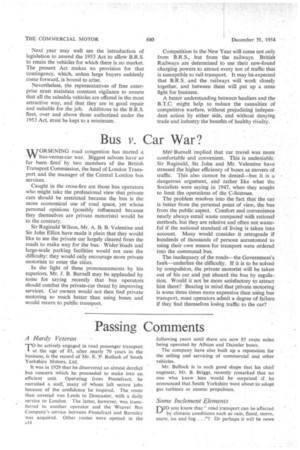Passing Comments
Page 16

Page 17

If you've noticed an error in this article please click here to report it so we can fix it.
A Hardy Veteran
TO be actively engaged in road passenger transport at the age of 83, after nearly 70 years in the business, is the record of Mr. E. .P Bullock of South Yorkshire Motors, Ltd.
It was in 1929 that he discovered an almost derelict bus concern which he proceeded to make into an efficient unit. Operating from Pontefract, he recruited a staff, many of whom left secure jobs because of the confidence he inspired. The route then covered was Leeds to Doncaster, with a daily service to London. The latter, however, was transferred to another operator and the Weaver Bus Company's service between Pontefract and Barnsley was acquired. Other routes were opened in the following years until there are now 85 route miles being operated by Albion and Daimler buses.
The company have also built up a reputation for the selling and servicing of commercial and other vehicles.
Mr. Bullock is in such good shape that his chief engineer, Mr. B. Briggs, recently remarked that no one who knew him would be surprised if he announced that South Yorkshire were about to adopt gas turbines or atomic propulsion.
Some Inclement Elements
DID you know that' road transport can be affected by climatic conditions such as rain, flood, storm, snow, ice and fog . . ."7 Or perhaps it will be news
to you that "large numbers of motor vehicles are in use . . ." and that "An outstanding feature of the modern motor vehicle is the pneumatic tyre. . . „" If it is thought that this is advance matter from the jubilee issue of The Commercial Motor to be published in March, the idea would be wrong. These platitudinous remarks are taken from "The Elements of Transport," by Leslie A. Schumer, recently published by Butterworths.
Even allowing for the fact that it w written in Australia, there is little excuse for such enlightening information as, "the capacity of a goods vehicle is limited by the total weighrwhich may be imposed on the floor. . . ." The italics are ours.
Assuming that the book is also intended for the education of people outside Australia, then Much of its contents is not only misleading but inaccurate.
That Foot-brake Switch
A MEMBER of the Cambridge centre of the 1-1. Institute of Road Transport Engineers deplored the lag which normally occurs in lighting the brake warning lamp because of the time occupied in moving the foot from the accelerator to the brake pedal.
To avoid this, he now attaches the switch control to the accelerator pedal and arranges it to come into action when this rises almost to its maximum.
Incidentally, switches for this purpose are nearly always mounted where mud and water are prevalent. There seems to be no reason why they should not be in a more sheltered position, such as under the bonnet, if their operation did not tend to become too complicated.
Stop Me and Shy One
14AULIERS are chuckling over the Christmas cards 1 4 of the British Transport Commission and the Road Haulage Association. Both the messages are based on the same theme, but with an unfortunate difference.
The Commission's card reproduces a fine oil painting in which a B.R.S. lorry is seen halted at a red traffic light. The R.H.A.'s greeting is brought by a happy medley of vehicles sailing past a signal giving the green light for 1955. .
Politics have a knack of insinuating themselves into the most unlikely places and apparently even Christmas is not sacrosanct.












































































